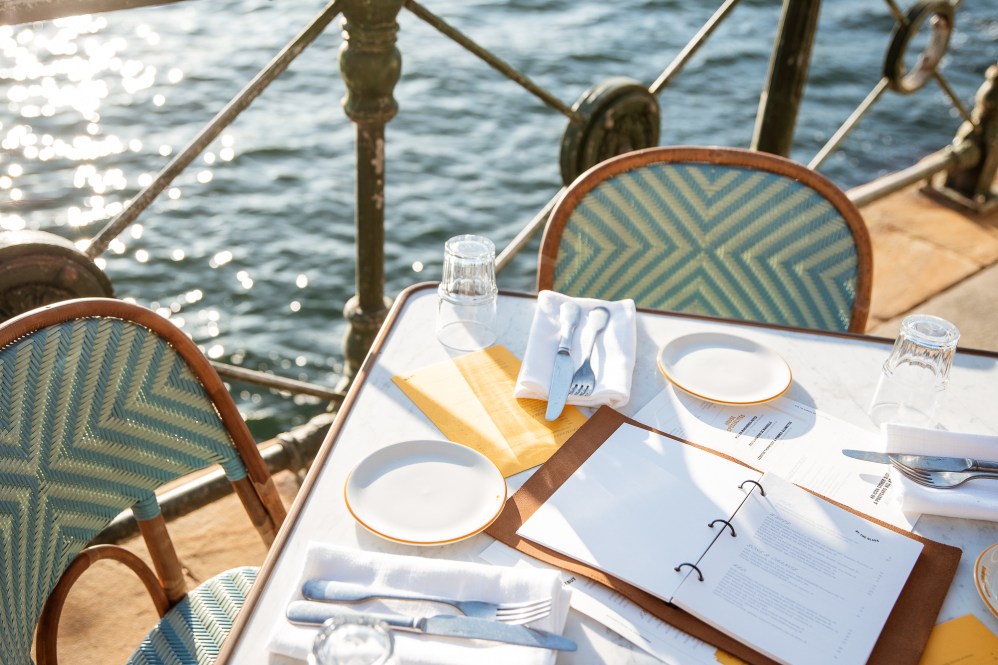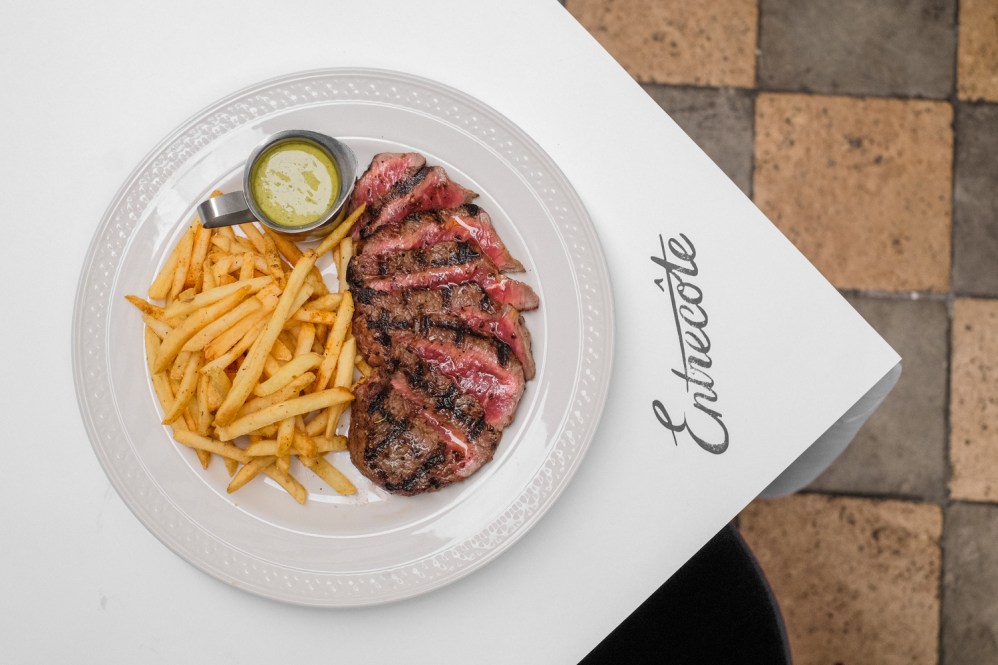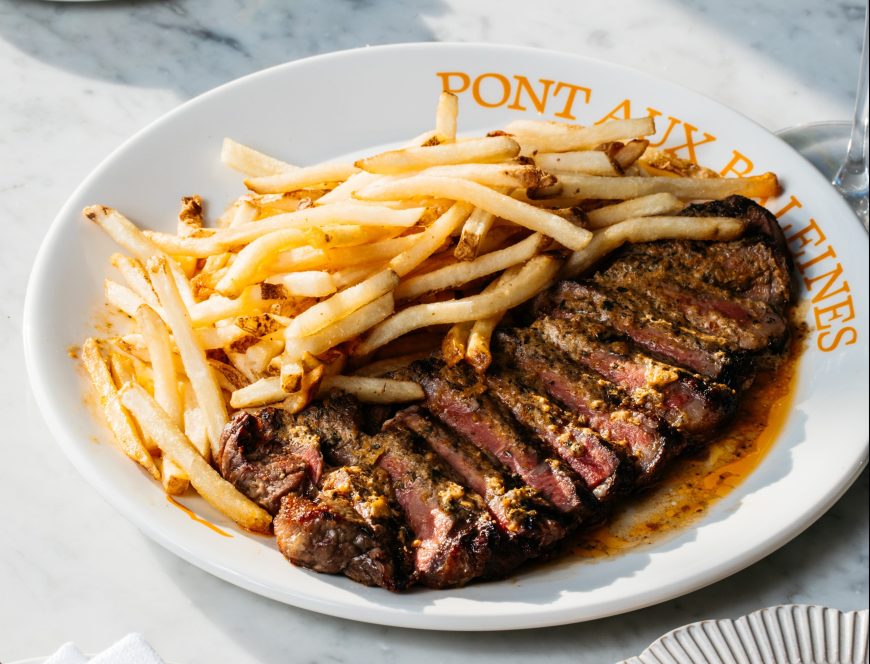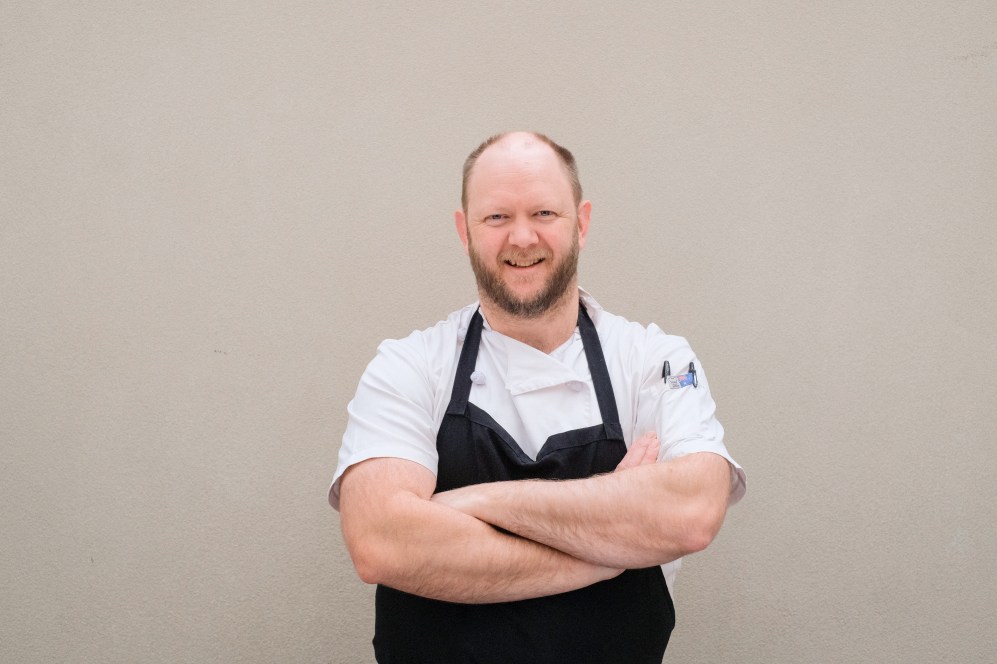Steak, chips and sauce are a trio that have stood the test of time. It’s one of the most versatile food combinations, with various forms appearing at casual and fine-dining venues. The most elevated version of the dish is perhaps steak frites, which has long been a staple at European brasseries.
Steak frites is a representation of the techniques and methods that are intrinsic to what European cookery is all about. From perfectly cooking the meat to creating a well-balanced sauce, there is a lot for chefs to consider.
Hospitality speaks to Tim Menger from Entrecôte and Will Elliott from Whalebridge about sourcing the right cuts of beef, the intricacies of the cooking process and why steak frites should never be overlooked.
Belgium and France both claim to be the inventors of steak frites. While most history books point to Belgium as the creator, the popularity of steak frites can be attributed to French chefs, who have mastered the dish.
Tim Menger from Entrecôte in Melbourne’s Prahran has made many plates of steak frites over his career and says it’s a dish that’s emblematic of France’s approach to food. “Steak frites encompasses a lot of what French bistro cooking is,” says the head chef. “It’s an interesting class of dish because you’ve got the very basic part of the frites, which you need to cook right to make sure they’re crunchy and crisp, but then you’ve also got the meat speaking for itself and the luxuriousness of the sauce.”
Will Elliott is no stranger to French cuisine. He recently moved from Hubert to take on the executive chef role of Whalebridge, which opened its doors in Sydney’s Circular Quay earlier this year.

The restaurant’s steak du jour frites is listed on the main menu and is a dish Elliott has long appreciated. “The first meal I ate in Paris was steak frites with exactly three ingredients: beef, potato and sauce and it was perfect,” he says. “The essence of steak frites is its simplicity. It is a single, contained and complete experience and an opportunity for a chef to express themselves.”
There are three main components that make up steak frites: the first is obviously steak, followed by frites (potato chips) and sauce. While it appears simple, each element needs to be cooked to meet its highest potential.
Steak is the hero component and starts with selecting the right cut of beef. Classic options include a New York strip or rib eye, but more contemporary cuts are coming to the fore as French cuisine progresses. “At Entrecôte, we don’t use the Entrecôte
cut, which is the rib eye,” says Menger. “We use Cape Grim grass-fed sirloin from a company called Flinders, which is supplied by Greenham farmers. It’s a good Tasmanian product.”
Sirloin is a leaner cut compared to rib eye and has a milder flavour profile along with some bite. “We tend to go for sirloin because it’s a more consistent cut and is easily portioned, which is helpful in a restaurant setting,” says Menger. “It’s also a cut Australians know and the quality is always there.”

Over at Whalebridge, Elliott has a different approach when it comes to selecting the right steak. “Personally, I lean towards flavour over tenderness and prefer cuts like bavette, onglet and tritip,” he says. “We use a variety of cuts and work with our suppliers to take advantage of good Australian beef.”
The restaurant relies on its relationships with suppliers to source top-quality meat. “We have three key beef suppliers who connect us with a number of producers up and down the east coast,” says Elliott. “One of my favourites is Jack’s Creek outside of Tamworth in New South Wales who have incredible products with a long history.”
Cooking a good steak is cheffing 101, with Menger and Elliott both chargrilling the beef. But first, the preparation. “I take the meat out so it reaches room temperature before putting it on the grill because we use a very hot gas grill,” says Menger.
The chef then seasons the 230–250g steaks with dried herbs and spices including toasted coriander seeds, smoked paprika, sea salt and black pepper. “You give it a good hit of seasoning and it goes on the grill,” he says. “It shouldn’t take too long to cook, which means your meat is not getting the shock.”
The cooking time is a matter of minutes, but the steak needs ample time to rest and let the juices settle. “We’ll probably rest it for around about 10 minutes because it’s a small piece of meat,” says Menger. “The resting time depends on the size. If you’re doing a 1kg T-bone, you’re going to rest it for 20 minutes or so.”
Elliott begins the cooking process by sous viding the steaks to the point of medium rare before finishing them on the grill. “It ensures the more flavourful and characterful cuts we use end up a lot more tender,” he says.
The beef is trimmed and portioned before being placed in a vacuum pack and sous vide. It is then removed from the plastic, “patted dry, seasoned and grilled to temperature and brushed with melted butter to encourage a deep brown colour”, relates the chef.

For Elliott, maintaining the beef’s natural flavour comes first. “Good products deserve to be treated respectfully,” says the chef. “Over-charring will leave a great steak bitter and dry, while a photogenic criss-cross on an otherwise grey steak won’t develop the true flavour of the beef.”
Steak frites requires a luxe sauce, and there are myriad options from béarnaise to peppery au poivre. Deciding which sauce to make is largely linked to the cut of meat. “Sauce béarnaise is a straight hollandaise,” says Menger. “You add some shallots and chopped tarragon and traditionally [serve it] with cuts like eye fillet.”
Menger opts for a traditional sauce a la maison or green sauce. “It’s a cross between a hollandaise and a mayonnaise in that you’re emulsifying egg yolks, mustard and whole butter and then mixing the herbs through,” he says. “It’s got anchovies to provide saltiness along with lemon juice and tarragon to cut through the richness.”
The chef melts butter and shallots in a pan at around 70 degrees Celsius and then adds capers, anchovies, chopped walnuts and herbs. Egg yolks are emulsified with Dijon mustard and Worcestershire before being combined with the butter mixture. “You mix in the herbs with the butter and blend it together,” says Menger. “You can do it with a bar blender or a stick blender. We bar blend because we make 6kg at a time.”
A more pared-back approach to sauces and accompaniments is taken at Whalebridge by pairing the steak with café de Paris butter, veal jus and optional sides. “The café de Paris butter is whipped and held at room temperature to be smeared across the finished steak before a few licks of hot veal jus,” says Elliott. “I also keep a selection of French mustards on hand for those who prefer more heat.”

The jus follows a traditional recipe that sees the juice from roasted veal bones and pork trotters combined with tomato, white wine, spices and herbs. “We reduce it until the flavour is full, not to a sticky glaze, and season it with white soy,” says Elliott. “The finished product has a full, clean, meaty flavour to complement the taste of the steak without drowning it.”
Frites, or fries, are a little more straightforward when it comes to preparation, but Entrecôte still pays plenty of attention to the humble carb. The frites at Entrecôte are fried in multiple stages in two separate deep fryers: one at 160 degrees Celsius and the other at 180 degrees Celsius. “The first fry seals the chip, which give you a surrounding crust and the second gives it a really hard crisp on the outside, so you’ve got an excellent crunchy texture,” says Menger.
French bistros are only increasing in prevalence in the Australian hospitality scene, so it’s no surprise one of its foundational dishes is also on the rise. “It demonstrates the values of a venue,” says Elliott. “The producer, cut of beef and how it is handled, the style of fries and seasoning, sauces and condiments all tell a story of the venue.”
Steak frites is an example of luxury meets simplicity and is a prime example of the dishes diners are currently responding to with gusto — everyone loves a classic. “What we do in restaurants is fancy it up a bit, but it still links back to its humble roots,” says Menger. “It’s something people can relate to while having the experience of extra luxury, and I think that’s important when it comes to cooking.”
Sponsored Content

Less Prep, More Plates: The Pastry Solution Built for Busy Kitchens
Sponsored by Goodman Fielder

Australian chefs choose ‘Best Mayonnaise’
Sponsored by Birch & Waite
Trending Now
Resources
Lorem ipsum dolor sit amet, consectetur adipiscing elit. Fusce ac ornare lectus. Sed bibendum lobortis...
Lorem ipsum dolor sit amet, consectetur adipiscing elit. Fusce ac ornare lectus. Sed bibendum lobortis...
Sign up for our newsletter
